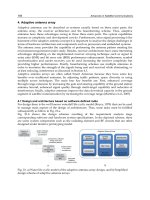Resource Management in Satellite Networks part 30 docx
Bạn đang xem bản rút gọn của tài liệu. Xem và tải ngay bản đầy đủ của tài liệu tại đây (455.47 KB, 10 trang )
276 Ulla Birnbacher, Wei Koong Chai
Fig. 8.17: Possible network topology with two VLANs available. See reference [44].
Copyright
c
2005 IEEE.
particular, UDP traffic is obtained via simulation of unidirectional constant-
rate video connections; also packet distribution is constant. Three UDP groups
of users have been considered that differ in terms of both bit-rate (i.e., 256,
128 and 64 kbit/s, respectively for Class I, II and III users), and the average
request inter-arrival time (which is exponentially distributed, so that the
arrival process of connection requests is Poisson). Mean inter-arrival times
are, respectively: 45 s for Class I, 22.5 s for Class II, and 11.25 s for Class III.
Each connection has a duration exponentially distributed with mean value of
180 s. The number of users in a group is selected so that each UDP group
offers 1 Mbit/s traffic in average, directed from nodes located in T1 to T2.
As for TCP-based traffic, the following results have been obtained by
considering the separate contribution of three groups of FTP users. Every user,
located in T1, requests files of B bytes, where B is exponentially distributed
with a mean of 5,000,000 bytes, while the file request inter-arrival time is
exponentially distributed with a mean of 5 s. User groups are differentiated
based on the available resources allotted in the access link: Class I (High
Rate) has an aggregate guaranteed rate of 512 kbit/s for the downstream
and 128 kbit/s for the upstream; Class II (Medium Rate) has an aggregate
guaranteed rate of 128 kbit/s for the downstream and 32 kbit/s for the
upstream; eventually, Class III (Low Rate) has an aggregate guaranteed rate
of 64 kbit/s for the downstream and 16 kbit/s for the upstream. Each group
saturates its link capacity due the high file request rate (5 files per second
are requested, i.e., about 25 MByte per second, which requires at least 120
Mbit/s plus the protocol overhead: the system is overloaded and the number
of FTP requests overwhelms the number of FTP sessions that reach the end of
transmission). As a matter of fact, simulations confirm the behavior described
Chapter 8: RESOURCE MANAGEMENT AND NETWORK LAYER 277
in Table 8.6 for UDP and the considerations about TCP in Table 8.7. Details
are provided below.
Fig. 8.18: UDP throughput with STP, no VLANs.
Fig. 8.19: UDP throughput with RTSP, no VLANs.
Figures 8.18 to 8.20 show the throughput of a unidirectional UDP connec-
tion between two remote hosts. In the simulations, a physical topology change
occurred at t = 950 s, and one can notice that a traditional STP approach
requires up to 45 s to recover the path; using RSTP this time is shortened,
278 Ulla Birnbacher, Wei Koong Chai
but several seconds, about 10 s, are still needed to reconfigure the large
switched-network. On the contrary, preconfigured VLANs allow a seamless
handover, without service discontinuities. In Figure 8.20, a VLAN handover
is enforced at t = 940 s, just a few seconds before the physical topology change.
Similar considerations could be made by considering bidirectional UDP flows,
where the traffic is generated in each direction as in the unidirectional case.
Fig. 8.20: UDP throughput with VLAN handover.
Figures 8.21 and 8.22 depict the throughput of a TCP connection for
hosts requesting FTP files from a network server. In this case, traffic flows
are bidirectional, due to the presence of ACK packets in the return channel,
even though the connection is strongly asymmetric. In these simulations,
a topology change occurred at t = 800 s. By using STP (Figure 8.21) or
RSTP, we can notice a service interruption with a duration similar to that
experienced in UDP simulations, but the effect is partially masked by the
build up of long queues at the last satellite-to-ground station link, especially
for the TCP Class III, which is allotted the minimum resources. It is worth
noting that after the network reconfiguration, each traffic group aggregate
suffers from high fluctuation due to the synchronization of TCP flows after
the outage period. In particular, Class I experiences a very drastic fluctuation,
while lower rate traffic classes grow very slowly. Eventually, if we consider the
adoption of VLAN (Figure 8.22), with a handover operated at t = 790 s, no
significant variation can be noted in the traffic aggregate of each class. Again,
off-line configured VLANs allow ground stations to switch seamlessly between
VLANs, and avoid service discontinuities.
As for the flooding effects due to topology changes, first we consider
unidirectional UDP flows in the network, from site T1 to site T2. Figures
Chapter 8: RESOURCE MANAGEMENT AND NETWORK LAYER 279
Fig. 8.21: TCP throughput with STP, no VLANs.
Fig. 8.22: TCP throughput with VLAN handover.
8.23 and 8.24 represent data flooded by switches when no appropriate entries
are found in the filtering database. Each flooded data frame is accounted for
only once, no matter if multiple switches will flow again the same frame. In
practice, a flooding phase starts after an automatic route change, performed
by RSTP (or STP, not showed here). This is the reason why Figure 8.23
shows flooded packets for multiple sources after the first disrupted path is
recovered, which is not mandatory for the data path we are interested to.
280 Ulla Birnbacher, Wei Koong Chai
Fig. 8.23: Unidirectional UDP connections: normalized aggregated flooding
(RSTP).
Fig. 8.24: Unidirectional UDP connections: normalized aggregated flooding
(VLAN).
Thus, the flooding phase ends only after the network is fully reconfigured and
a new frame is sent in the reverse path for each user (i.e., after a new request
is sent per each UDP traffic class, which is represented, in these simulations,
by a single user). Figure 8.24 shows that by adopting VLAN-based network
management, a simple VLAN handover is required a few seconds before the
original path goes down. However, VLAN handover requires a brief flooding
phase just after the handover, since the filtering database learning phase has
to be performed as well.
Chapter 8: RESOURCE MANAGEMENT AND NETWORK LAYER 281
As for the flooding effects in case of bidirectional UDP connections, in the
same network and traffic conditions as before, it can be found a very limited
flooding due to the fact that an intense traffic is used in both directions, so
that database learning phases are very short.
Figure 8.25 shows the burden of flooding data for TCP connections when
RSTP is adopted. Data are related to frames carrying TCP segments (data
and ACKs) that experience at least one duplication in a generic network node.
Due to the asymmetric nature of TCP upstream and downstream (i.e., the
different size and bandwidth occupied by data and ACKs), it is appropriate
to distinguish between the amount of flooded bits and the number of flooded
frames: we represent the flooding in terms of flooded packets, which give
a normalized estimate of how much dangerous the flooding can be. Note
that flooding occurs while the network is reconfiguring itself. However, RSTP
operation allows data to be flooded immediately after the link failure. In fact,
when using spanning trees, each link is represented as an arch of an oriented
graph. The orientation of each arch is from the root to the leaves of the
tree. Thus, a link connects an up-node to a down-node. Using RSTP, the
down-node is in charge of sensing the link failure and starting the recovery
phase; the down-node is also allowed to use alternative links to reach the
root of the tree. The most important cause of flooding in RSTP is given by
frames that reach a down-node of a broken link. Eventually, flooding is almost
completely avoided by using VLANs, as stated by Figure 8.26.
Fig. 8.25: TCP connections: normalized aggregated flooding (RSTP).
282 Ulla Birnbacher, Wei Koong Chai
Fig. 8.26: TCP connections: normalized aggregated flooding (VLAN).
8.7 Conclusions
Over the past decades, with the emergence of many multimedia Internet
applications and services, the research community has devoted a big effort
in an attempt to satisfy their stringent and varied QoS requirements. A clear
example of this effort is the initiative by IETF in proposing two IP QoS
frameworks. These frameworks are mainly designed with terrestrial networks
in mind. However, the problems of achieving QoS in networks with wireless
medium such as satellite networks are much more complicated since the link
is dependent on channel conditions. Hence, the resource management block is
vital in realizing the IP QoS frameworks.
Standard mechanisms which operate solely in the network layer most
often cannot guarantee the QoS when the end-to-end path involves satellite
or wireless networks as they disregard the variability of channel conditions.
This leads to the investigation of utilizing MAC layer resource management
schemes or protocols to improve this situation. More recently, the idea of using
cross-layer techniques further open up the potential of what can be achieved
in terms of QoS provision.
Being in adjacent layers in the protocol stack, resource management (layer
2) in satellite networks is always tightly coupled with the IP QoS frameworks
(layer 3). This Chapter has been dedicated to the cross-layer interactions and
issues between these two layers. A review of the current state of the IP QoS
frameworks in relation with the satellite network shows that DiffServ is being
increasingly accepted and an example implementation of relative DiffServ is
given as an illustration on how MAC layer scheduling can support the QoS
provisioning. The problem of mapping between the QoS mechanisms operating
at the two layers has been formulated and a measurement-based approach has
Chapter 8: RESOURCE MANAGEMENT AND NETWORK LAYER 283
been presented. The problem is also discussed in two other scenarios; namely
the dual network access and Switched Ethernet over LEO satellites.
From the discussions and results presented in this Chapter, it is clear
that achieving IP QoS in a satellite environment can certainly benefit from
cross-layer mechanisms from layer 2. Nevertheless, caution must be observed
when designing such cross-layer schemes. Uncontrolled implementation of
cross-layer mechanisms may cause other problems that may not be apparent
in a short period of time. Cross-layer design aimed at improving a specific
performance metric may not have the entire system performance considered
while cross-layer design involving multiple layers may lead to ‘spaghetti design’
with high number of convoluted interactions. All these aspects will increase
system complexity and hence will pose problems for future innovations. Worse,
system update may require complete redesign. Another example of a negative
impact of uncontrolled cross-layer design is on network security issues: the
increased interactions among layers may increase the channels for security
attacks. In conclusion, designers must have the long-term effects in mind.
References
[1] S. Shenker, J. Wroclawski, “General Characterization Parameters for Integrated
Service Network Elements”, IETF RFC 2215, September 1997.
[2] R. Braden, D. Clark, S. Shenker, “Integrated Services in the Internet
Architecture: an Overview”, IETF RFC 1633, June 1994.
[3] R. Braden, L. Zhang, S. Berson, S. Herzog, S. Jamin, “Resource Reservation
Protocol (RSVP) - Version 1 Functional Specification”, IETF RFC 2205,
September 1997.
[4] S. Shenker, C. Partridge, R. Guerin, “Specification of Guaranteed Quality of
Service”, IETF RFC 2212, September 1997.
[5] J. Wroclawski, “Specification of the Controlled-Load Network Element Service”,
IETF RFC 2211, September 1997.
[6] S. Blake, D. Black, M. Carlson, E. Davies, Z. Wang, W. Weiss, “An Architecture
for Differentiated Services”, IETF RFC 2475, December 1998.
[7] C. Dovrolis, D. Stiliadis, P. Ramanathan, “Proportional Differentiated Services:
Delay Differentiation and Packet Scheduling”, IEEE/ACM Transactions on
Networking, Vol. 10, No. 1, pp. 12-26, February 2002.
[8] K. Wang. Quality of Service Assurances in Multihop Wireless Networks.PhD.
Dissertation, University of Wisconsin-Madison, 2003.
[9] Y. Xue, K. Chen, K. Nahrstedt, “Achieving Proportional Delay Differentiation
in Wireless LAN via Cross-Layer Scheduling”, Journal of Wireless
Communications & Mobile Computing, Vol. 4, No. 8, pp. 849-866, November
2004.
[10] W. K. Chai, M. Karaliopoulos, G. Pavlou, “Scheduling for Proportional
Differentiated Service Provision in Geostationary Bandwidth on Demand
Satellite Networks”, in Proc. of IEEE GLOBECOM 2005, St. Louis, MO, USA,
November 28 - December 2, 2005.
[11] E. Rosen, A. Viswanathan, R. Callon, “Multiprotocol Label Switching
Architecture”, IETF RFC 3031, January 2001.
[12] ETSI, “Digital Video Broadcasting (DVB); Interaction channel for satellite
distribution systems,” ETSI European Standard (Telecommunications series),
EN 301 790 V1.3.1 (2003-03).
[13] G. A¸car. End-To-End Resource Management in Geostationary Satellite
Networks. PhD. Dissertation, University of London, November 2001.
[14] L. Kleinrock. Queueing Systems. New York, Wiley, 1976, Vol. II.
286 Ulla Birnbacher, Wei Koong Chai
[15] ETSI, “Satellite Earth Stations and Systems (SES). Broadband Satellite
Multimedia, Services and Architectures”, ETSI Technical Report, TR 101 984
V1.1.1, November 2002.
[16] ETSI, “Satellite Earth Stations and Systems (SES). Broadband Satellite
Multimedia, IP over Satellite”, ETSI Technical Report, TR 101 985 V1.1.2,
November 2002.
[17] N. Iuoras, T. Le-Ngoc, “Dynamic Capacity Allocation for Quality-Of-Service
Support in IP-Based Satellite Networks”, IEEE Wireless Communications
Magazine, Vol. 12, No. 5, pp. 14-20, October 2005.
[18] N. Iuoras, T. Le-Ngoc, M. Ashour, T. Elshabrawy, “An IP-Based Satellite
Communication System Architecture for Interactive Multimedia Services”,
International Journal of Satellite Communications and Networking, Vol. 21,
No. 4-5, pp. 401-426, July-October 2003.
[19] T. Le-Ngoc, V. Leung, P. Takats, P. Garland, “Interactive Multimedia Satellite
Access Communications”, IEEE Communications Magazine,Vol.41,No.7,pp.
78-85, July 2003.
[20] S. Combes, L. Goegebeur, M. Fitch, G. Hernandez, A. Iuoras, S. Pirio,
“Integrated Resources and QoS Management in DVB-RCS Networks”, in Proc.
of the 22
nd
AIAA International Communications Satellite Systems Conference
& Exhibit 2004 (ICSSC), Monterey, CA, May 2004.
[21] M. Marchese, M. Mongelli, “Rate Control Optimization for Bandwidth
Provision over Satellite Independent Service Access Points”, in Proc. of IEEE
Globecom 2005, St. Louis, MO, USA, pp. 3237-3241, November 28 - December
2, 2005.
[22] M. Marchese, M. Mongelli, “On-Line Bandwidth Control for Quality of
Service Mapping over Satellite Independent Service Access Points”, Computer
Networks, Vol. 50, No. 12, pp. 1885-2126, August 2006.
[23] M. Marchese, M. Mongelli, “Real-Time Bandwidth Control for QoS Mapping of
Loss and Delay Constraints over Satellite Independent Service Access Points”,
submitted to IEEE Transactions on Wireless Communications.
[24] C. G. Cassandras, G. Sun, C. G. Panayiotou, Y. Wardi, “Perturbation
Analysis and Control of Two-Class Stochastic Fluid Models for Communication
Networks”, IEEE Transactions on Automatic Control,Vol.48,No.5,pp.
770-782, May 2003.
[25] N. Celandroni, F. Davoli, E. Ferro, “Static and Dynamic Resource Allocation in
a Multiservice Satellite Network with Fading”, International Journal of Satellite
Communications and Networking, Vol. 21, No. 4-5, pp. 469-487, July-October
2003.
[26] Y. Wardi, B. Melamed, C. G. Cassandras, C. G. Panayiotou, “Online IPA
Gradient Estimators in Stochastic Continuous Fluid Models”, Journal of
Optimization Theory and Applications, Vol. 115, No. 2, pp. 369-405, November
2002.
[27] R. Gu´erin, H. Ahmadi, M. Naghshineh, “Equivalent Capacity and its
Application to Bandwidth Allocation in High-Speed Networks”, IEEE Journal
on Selected Areas in Communications, Vol. 9, No. 7, pp. 968-981, September
1991.
[28] Web site with URL:
/>









